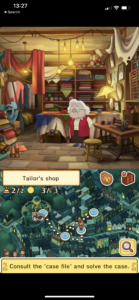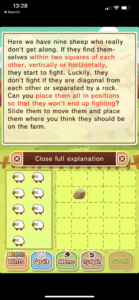
Overview
Layton’s Mystery Journey: Katrielle and the Millionaires’ Conspiracy is a puzzle game developed by Level-5. The game was released for different platforms, including Android, iOS, Nintendo 3DS, and Nintendo Switch. I played on my iPhone (although I noticed that the controls were a bit awkward on mobile since Professor Layton games are usually designed for two screens like a classic Nintendo DS). The game stars Kat Layton, the young daughter of Hershel Layton, and follows her adventures as she opens a detective agency. The advertised target audience of the game is ages 10 and older.
Formal Elements + Types of Fun


The primary kinds of fun evoked by the game are Narrative and Challenge: Although each of the case files is technically independent, each of the cases builds upon previous information to advance the main storyline that leads up to a climax in the final case. Furthermore, there is a strong cast of characters (including Ernest and Sherl the dog) whose storylines become relevant later on in the game. In addition, each of the puzzles in the game is a challenge for the player to solve, whether it be putting a picture back together, thinking outside the box, or doing some mental math. The wide range of puzzles and mini-games also allows players to set their own goals for the game — some, like me, are completionists that try to find and solve every single puzzle, while others only focus on specific types of puzzles or ignore ones that aren’t essential for the main storyline.
My Impressions
What Works
- Enjoyable storyline: I really liked how the 12 case files came together at the end to create one overarching narrative — it made the time I invested into the game feel a lot more worthwhile.
- Graphics are cute: Honestly, one of the main things that I loved about Layton’s Mystery Journey is the graphics. The whole theme felt very whimsical, in line with the main character being Professor Layton’s excitable daughter (rather than the Professor himself). I found myself getting a lot of delight out of the cute illustrations that I got to see as I explored London as Kat.
What Could Be Improved
- Controls are awkward: I think it was quite obvious that Professor Layton games are originally designed for consoles with two screens (i.e. a Nintendo DS) — the layout was basically directly ported to mobile, and I honestly don’t think it made a lot of sense to split up the phone screen in two.
- Some puzzles have weird “gotcha” moments: There are many different types of puzzles in Professor Layton games (e.g. logical, piece positioning, pictorial, etc.), and I think that some of them fell flat for me. This is because some puzzles require a “gotcha” kind of insight moment that I wouldn’t have been able to come up with by myself without looking at the hints. However, I did appreciate that in-game hints (unlockable by spending hint coins that are found in various locations throughout the game) existed, since it usually prevented me from turning to the internet for solutions.


